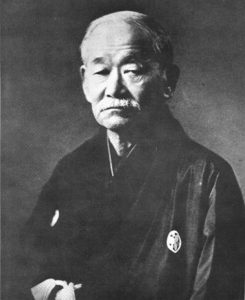Efforts to ascribe philosophical meaning to various martial arts seem perennial, but documents supporting origin claims are often transparently contrived or unsupported. Notable exceptions are China’s Shaolin kung fu, developed centuries ago and still taught at the Chan (Japanese: Zen) Buddhist Shaolin temple in China, and Japan’s Shorinji Kempō, developed to popularize the school’s Zen practice. Many koryū (ancient Japanese martial arts) claim unique philosophies but cite tales of inspiration by intense, training-inspired visions or even visitations by tengu (long-nosed goblins). But the genuine philosophical roots of one modern Japanese martial art practiced worldwide were misunderstood, overlooked, then finally lost to history. That art is jūdō, a modernized version of jūjutsu, the ancient samurai martial art of fighting barehanded.
Although Kanō spoke about his jūdō philosophies frequently in Japanese and occasionally in English for decades, he never disclosed their origins, and their exact meaning escaped jūdōka for nearly 100 years. While his writings were clearly influenced by ancient Eastern philosophy more than 2,200 years old, this paper, adopted from the forthcoming manuscript The Kanō Chronicles: The Untold History of Modern Japan,® will show how the core of his philosophy came from 19th century English philosophers.
Lance Gatling
Author / Lecturer
The Kanō Chronicles
Tokyo, Japan
Contact@kanochronicles.com – please send a note to give us feedback.
Thank you!
©2021 Lance Gatling, The Kanō Chronicles
Discover more from The Kano Chronicles© 嘉納歴代©
Subscribe to get the latest posts to your email.

Lance sensei, thank you for this inspiring post. May I have your permission, to cite the article in a paper I’ll be writing in a philosophy course? If so, how should I reference it? Thank you.
LikeLiked by 1 person
Hello. Thanks for your note; I’m glad you found it inspirational. I believe this should affect interpretations of Kanō shihan’s activities. Certainly his approach to publishing from the mid-1920s is enlightened by understanding this.
The citation should read like the below (this is the Chicago style for an unpublished conference paper, adjust if you use a different style). And thank you for asking.
Gatling, Lance.
“The Historical Background and Philosophic Basis of Kanō Jigorō’s Jūdō Principles Seiryoku Zenyō Jita Kyōei (Best Use of Energy / Mutual Prosperity).”
Paper presented at the Society for the Study of Philosophy and the Martial Arts Annual Meeting, Online, March 2021.
LikeLike
PS – if appropriate, I’d be curious to see your paper, too.
Lance Gatling
LikeLike
Good morning. Thank you for your prompt reply and for agreeing to be cited. The paper has yet to be written (the term has only just begun) but I’ll be happy to let you see it. I have a feeling that I will be reverting to Kano Sensei’s philosophy more than once. I see judo everywhere. In fact, I just applied it to the fluidity of the nebulae vortex in van Gogh’s The Starry Night. And the idea that asymmetrical composition maintains balance blew me away.
Stay safe.
Trish
LikeLike